Shared dreams involve experiences where people reportedly connect and share the same dream environment, often during lucid states. While many anecdotal reports describe vivid interactions and familiar symbols appearing in these dreams, scientific proof remains limited and unverified. Experts suggest that subconscious synchronization, collective symbolism, or imagination may foster these connections. Although evidence isn’t conclusive, exploring this fascinating phenomenon can reveal new insights into our subconscious and the potential for shared experiences—continuing your journey might uncover even more intriguing possibilities.
Key Takeaways
- Scientific evidence for mutual dreaming remains anecdotal with limited empirical validation.
- Shared dreams often involve vivid interactions and familiar environments, suggesting subconscious connections.
- Theories propose collective subconscious and subconscious synchronization as mechanisms for shared dreaming.
- Recognizable symbols and themes across dreams may serve as communication bridges in shared dream states.
- Despite scientific challenges, shared dreams highlight the mind’s potential for connection and symbolic messaging.

Have you ever wondered how different people can share the same dream, feeling connected across distances and experiences? The idea of shared dreams has fascinated many, sparking curiosity about whether our minds can truly intertwine during sleep. Some believe that through lucid dreaming, where you’re aware you’re dreaming and can even control the dream’s course, it’s possible to connect with others in a shared dream space. This concept suggests that certain dream symbolism might serve as a universal language, revealing subconscious messages that transcend individual minds. When you develop the skill of lucid dreaming, you might notice recurring symbols or themes—like a specific animal, place, or object—that seem to carry shared meaning across different dreamers. These symbols could act as bridges, allowing multiple minds to communicate or recognize each other’s presence within a dreamscape.
The evidence for mutual dreaming remains largely anecdotal, but many who practice lucid dreaming report experiences that resemble shared dreaming. They describe entering a lucid state and then connecting with someone else’s consciousness, often through vivid, detailed interactions. These encounters often include recognizable dream symbolism, which helps anchor the experience. For example, a person might find themselves in a familiar setting, like a beach or forest, with a partner who shares the same dream symbols. This shared environment can foster a sense of unity and understanding that feels real, even if it’s difficult to verify scientifically. Some researchers speculate that these shared visions could stem from the brain’s ability to generate complex, meaningful symbols during lucid dreaming, serving as a kind of collective subconscious. Additionally, exploring dream symbolism can enhance our understanding of how subconscious messages might function across individual minds.
While scientific validation is limited, theories suggest that shared dreams might occur through a combination of subconscious synchronization and heightened awareness. If your mind is attuned to dream symbolism—such as recognizing a recurring motif—it might facilitate a connection with someone else who is experiencing similar symbols. This is especially true during lucid dreaming, where your conscious awareness allows you to navigate and influence the dream environment intentionally. You might find yourself collaborating with a dream partner, exploring symbolic scenarios together and exchanging ideas through shared imagery. These experiences, while still speculative, highlight how powerful and mysterious dreams can be. Whether or not shared dreaming is fully understood, it’s clear that the subconscious mind is capable of remarkable feats—bridging distances and connecting across individual realities through the language of symbols and conscious awareness.
Frequently Asked Questions
Can Shared Dreaming Be Scientifically Proven?
You wonder if shared dreaming can be scientifically proven. While some studies suggest phenomena like lucid dreaming and dream telepathy, solid scientific evidence remains elusive. Researchers have documented cases where individuals report shared experiences, but these are often anecdotal or lack rigorous verification. To truly prove shared dreaming, you’d need consistent, replicable experiments, which currently haven’t been achieved. So, at this point, shared dreaming remains an intriguing but unproven phenomenon.
What Psychological Factors Influence Mutual Dreaming Experiences?
Have you ever wondered what shapes mutual dreaming? Psychological factors like subconscious connections and emotional synchronization play key roles. When you feel deeply connected or synchronized emotionally with someone, it can enhance the likelihood of shared dreams. Your subconscious may pick up on subtle cues, fostering these experiences. So, it’s not just chance; your emotional bonds and subconscious links influence whether you and someone else might share dreams.
Are Shared Dreams More Common in Certain Cultures?
You might notice that shared dreams appear more common in cultures with rich traditions of dream symbolism and spiritual practices. Cultural variations influence how people interpret and value dreams, making mutual dreaming more prominent in some societies. In these cultures, dreams often hold collective significance, fostering a sense of connection. So, your chances of experiencing shared dreams can depend on cultural beliefs and the importance placed on dream symbolism.
How Do Shared Dreams Impact Real-Life Relationships?
Shared dreams can strengthen your real-life relationships by fostering dream synchronization and deepening emotional connections. When you experience mutual dreaming, you may feel more understood and connected to others, enhancing trust and intimacy. These shared experiences can serve as a unique form of communication, allowing you to explore subconscious feelings together. As a result, your emotional bonds grow stronger, positively impacting your relationship’s overall quality and resilience.
Are There Technological Methods to Induce Shared Dreaming?
You can explore technological methods to induce shared dreaming by combining lucid dreaming techniques and sleep cycle manipulation. Devices like sleep trackers and neurostimulation tools aim to enhance your awareness during REM sleep, increasing the chances of shared dreams. While still experimental, these methods show promise in helping you connect with others in the dream world, making mutual dreaming more achievable through targeted interventions during your sleep cycles.
Conclusion
As you close your eyes, imagine the delicate threads of connection weaving two minds together in a silent dance. Shared dreams shimmer like distant stars, flickering with echoes of each other’s whispers. Though the evidence remains elusive, the possibility of mutual dreaming invites you to see beyond the veil, where consciousness intertwines in a silent symphony. Maybe, just maybe, your dreams aren’t entirely your own—they’re echoes of a shared universe waiting to be uncovered.









